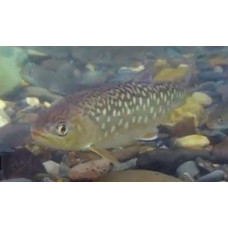Salvelinus leucomaenis is a migratory fish of the char genus. It has large light-colored spots on its body. It is a marine fish that spends most of its life in the sea, entering rivers only for breeding. Matures in the fourth year of life. Spawns in June-September, repeatedly. Fecundity up to 2.3 thousand eggs. It feeds mainly on fish.
Large fish - its maximum size reaches more than 1 m and about 11 kg, although fish measuring 30-60 cm and 0.5-3 kg are most often caught. It differs from Arctic char by a smaller number of gill stamens (16-18, 12 in small specimens). The back of the fish is dark, the belly is light, silvery, and the sides are brownish with large light spots.
It inhabits the Pacific Ocean basin from Penzhina, the Commander Islands and Kamchatka to Hokkaido Island. It is also found on the Kuril and Shantar Islands, along the entire Okhotsk coast and in the Amur River. It is found as far as Peter the Great Bay.
Salvelinus leucomaenis is a passable char. It enters rivers and lakes for spawning. It reaches sexual maturity in the 3-4th year of life at a length of 23-40 cm. Spawning in different areas takes place from June to September. The eggs are buried, spawned individuals remain in the river until spring, and then go to the sea. Juveniles spend 2-4 years in the river, after which they begin to roll into the sea to fatten up during the summer months. During their stay in the river, juveniles feed on the larvae of streamers and other insects. The life span of Salvelinus leucomaenis is 10 years. During the period of feeding in the sea Salvelinus leucomaenis does not make long migrations and stays in pre-mouth sections of rivers or near the coast. In summer, it actively feeds on small smelt, sand lance, gobies, and juvenile Pacific salmon as they roll into the sea. It returns to rivers for wintering. Adult Salvelinus leucomaenis is an active predator. It has local commercial importance and is the object of sport fishery.
Salvelinus leucomaenis
Tags: salvelinus leucomaenis


